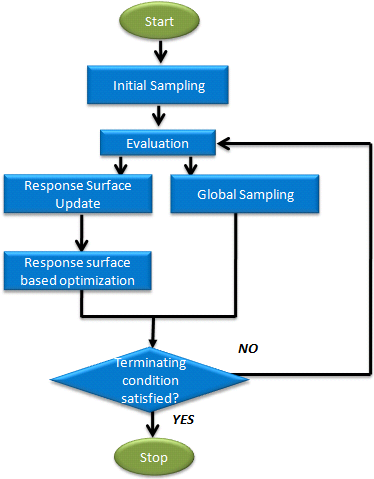Global Response Search Method (GRSM)
A response surface based approach. During each iteration, the response surface based optimization generates a few designs. Additional designs are generated globally to ensure a good balance on local search capability and global search capability. Response surface is adaptively updated with the newly generated designs to have a better fit of the model.
Usability Characteristics
- Global Response Search Method can disposes of both single objective problems and multi-objective problems.
- Default method for multi-objective optimization problems. Global Response Search Method is also the suggested method when you are solving a single objective optimization problem with a large number of input variables and/or when a global optima is required.
- It is recommend to use Global Response Search Method directly on a solver and not on a Fit. If you have a Fit, consider using an Inclusion matrix with your data.
- Consists of a global search capability.
- Supports discrete optimization.
- All the designs generated in one iteration can be solved in parallel.
- If the model analysis is time consuming, then Global Response Search Method is a good choice. If the model analysis is quite cheap and a thorough search of the design space is needed (for example, 100000 model evaluations are needed), then Genetic Algorithm or Multi - Objective Genetic Algorithm are recommended.
- In the case of a failed run, it is possible to ignore a failed analysis or terminate an optimization. When omitting failed runs, the optimizer randomly generates designs in under-sampled region in order to explore the whole design space effectively.
- Terminates when the maximum number of evaluations (Number of Evaluations) is reached.
- Supports input variable constraints.
- The size of the first iteration is controlled by the Initial Sampling Points setting. The number of evaluations in subsequent iterations is controlled by the Points per Iteration setting. All designs generated within one iteration can be executed in parallel.

Figure 1. Global Response Search Method Process Phases
Settings
| Parameter | Default | Range | Description |
|---|---|---|---|
| Number of Evaluations |
|
>0 | Number of evaluations allowed. |
| On Failed Evaluation | Terminate optimization |
|
|
| Parameter | Default | Range | Description |
|---|---|---|---|
| Initial Sampling Points | min(20,n+2) | Integer >=0 |
The number of initial sample points. Default is min(20,n+2) initial sample points; n is the number of input variables; > 0 use the user defined value. |
| Random Seed | 1 | Integer 0 to 10000 |
Controlling repeatability of runs
depending on the way the sequence of random numbers is
generated.
|
| Points per Iteration | 2 | 1 to Initial Sampling Points | Number of designs to be evaluated for optimum design search
and response surface update. After the initial Initial Sampling
Points designs, Points per
Iteration designs are generated from response surface based
optimization and/or incremental sampling. In the iteration
that follows, these designs are used to adaptively update
the response surface to have a better fit of the model.
Note: These designs can be evaluated in
parallel.
|
| Max Failed Evaluations | 20,000 | >=0 | When On Failed Evaluations is set to Ignore failed evaluations (1), the optimizer will tolerate failures until this threshold for Max Failed Evaluations. This option is intended to allow the optimizer to stop after an excessive amount of failures. |
| Stop after no Improvement | 1000 | > 0.0 | Terminates the optimization if the number of iterations without improvement exceeds this value. |
| Use Inclusion Matrix | No |
|
|